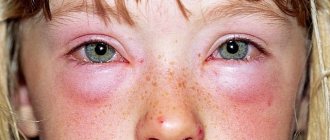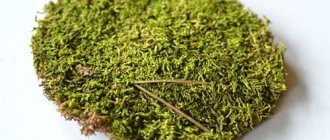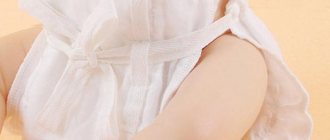Can there be a reaction to diapers?
What does a diaper allergy look like? Photo:
Diapers are a daily hygiene product for a child. Major manufacturers of disposable diapers undergo strict testing of all materials for the presence of allergens . Entire laboratories constantly monitor the quality of their products.
But even such precautions do not guarantee 100% protection from allergies for absolutely everyone.
In case of individual intolerance to certain materials or components included in the diaper, the baby’s skin may show an allergic reaction.
Differences between diapers and diapers (explanation)
Some people believe that diapers and diapers are synonymous. This is only partly true.
The term diaper refers to any type of waterproof hygiene product used to prevent the skin of the buttocks, perineum and legs from getting wet.
These products, in principle, can be made from any type of material; our mothers mainly used gauze.
Naturally, they were not completely dry, but they prevented rompers and other items of clothing from getting dirty.
Diapers can be disposable, but those made using waterproof materials can be reusable.
The external shape of the diapers is similar to a rectangle, and they are secured to the body using side fasteners.
Inside the product there is a gel or other absorbent substance designed to collect urine and the liquid part of feces.
What is a diaper then? This term refers to a company that produces diapers. And it must be said that diapers are always disposable products; they also include another model made in the form of panties.
What is an allergen?
Flavors, fragrances and various chemicals that are included in the gel layer of the diaper are the main stimulator of an allergic reaction .
Also, the fabric of the diaper itself is impregnated with a special chemical solution, which can cause allergies.
Which diapers most often cause allergies? Large brands that have built their reputation and customers over the years produce quality products. An allergic reaction to such diapers is an isolated case .
The most common diaper allergies are:
- Contains a gel filler with additives (aloe, chamomile, etc.).
- Released in violation of technological standards ( counterfeit of a well-known brand).
Read about how to prevent spring vitamin deficiency in a child here.
Signs
How does an allergy to diapers manifest? Young children have several types of allergies: food (to new foods) or household (washing powder, cosmetics, cream, powder).
Therefore, it is very important to understand what exactly triggered the allergic reaction. If food and household allergies are excluded, then thanks to certain symptoms, the true cause of the allergy can be established.
Diaper allergy symptoms and signs:
- redness of the skin . The skin changes its color only under the diaper, the rest of the skin remains unchanged;
- small rash . A small rash appears in places where the skin comes into contact with the diaper;
- itching and peeling of the skin . The skin under the diaper begins to dry out and peel;
- swelling _ In case of a severe allergic reaction, swelling of the skin under the diaper may occur;
- child's irritability . As soon as the baby is put on a diaper, after a short time he begins to cry, be capricious, and behave restlessly.
The allergic reaction begins in the diaper, but can then spread throughout the body.
Therefore, you should show the child to the doctor as soon as possible and begin treatment.
An allergy to a diaper can occur under the following circumstances:
- new brand of diaper .
- We purchased diapers containing plant extracts (chamomile, aloe, etc.) that had not been used before.
- An allergy to a regular brand of product can only appear when a low-quality product (counterfeit) was purchased.
What can allergies be confused with?
Allergic manifestations caused by diapers can easily be mistaken for prickly heat, a fungal infection, or contact dermatitis, which occurs as a result of friction of the product against the skin in the areas of the tightest fit.
Given this confusion, pediatricians give clear recommendations on how to most accurately determine an allergy to diapers :
- completely stop using them for a few days;
- regularly and as responsibly as possible carry out all necessary procedures for caring for the baby’s skin;
- After the symptoms completely disappear, put a diaper on the child for no more than 40 minutes (make sure that his skin is dry and clean).
If after removing the product no changes were found underneath, then you are not dealing with an allergy. Most likely, the cause of the trouble was untimely changing of the diaper, prolonged contact of the skin with feces and urine, or incorrect selection of the product in size.
To make sure that other hygiene products used in everyday care have not caused allergies, you can treat the skin with them and leave the baby without a diaper. If this is the reason, the reaction will come quickly.
Diagnostics
Diagnostics is as follows:
- It is necessary to examine the baby's skin.
- Identify symptoms of an allergic reaction (redness, rash, itching, swelling).
- Eliminate the allergen (the baby's diaper must be removed immediately).
- Show the child to the doctor and then follow the specialist’s recommendations regarding the treatment of the baby.
How does autism manifest in a child? Find out the answer right now.
Reusable diapers as an alternative
If traditional disposable options are absolutely not suitable for your baby, you can try reusable ones as an alternative. Purchasing them will not be difficult - the market offers a selection of products from different manufacturers (for example, Russian Mum's Era). You can also make them from a regular T-shirt with your own hands.
Reusable products are special panties with replaceable inserts. They are made exclusively from natural materials; bamboo or microfiber is used for pads. This option is safer in terms of possible allergic reactions.
Depending on the model, immediately after your baby has relieved himself, you will have to change the entire diaper or just the insert. The products are easy to wash, dry quickly and can be used the very next day after washing. The number of diapers per day depends on the age of the child.
If you are considering this option, it is worth considering that the price is significantly higher than disposable models. However, thanks to the adjustable size (in most cases they are suitable from birth to 1-2 years) and the possibility of repeated use, the costs are quickly recouped.
The disadvantages of the products include the need for frequent washing; in this sense, they are almost similar to the diapers that were used by our mothers and grandmothers.
In addition, the experience of mothers shows that it is advisable not to completely abandon disposable models: they are useful for nighttime sleep and in cases where you and your baby leave the house for a long time.
As for allergies, when using reusable diapers, they are less common, since fragrances, plant extracts and other dubious components are not used in production. However, negative reactions are possible if the baby is hypersensitive to natural materials.
What to do if you notice symptoms?
First aid for a baby who has an allergic reaction to a diaper may include the following:
- Remove the diaper immediately .
- The skin that has been in contact with the diaper should be carefully washed with warm water . This can be done using a small piece of gauze. Rinse irritated skin with gentle blotting movements, and do not rub the skin under any circumstances.
- Leave the baby without a diaper for 15-20 minutes to allow . ”
- Take the child to the doctor immediately.
- Do not use diapers while the allergic reaction lasts. Instead, you can use pieces of gauze and oilcloth.
What not to do if you are allergic to a diaper:
- Treat redness and rashes on the skin with drying medications: brilliant green, iodine and a solution of potassium permanganate.
- Use healing creams and ointments without consulting a doctor.
- Put your child on a new disposable diaper, even from a trusted company.
Preventive measures against flea bites in children
To prevent the situation when fleas bite a child from happening again, preventive measures should be taken in the house or apartment:
- to repel insects in the house, you can hang branches of wormwood and tansy, which do not tolerate such odors;
- pour pine sawdust into pet bedding and add wormwood;
- to protect a child from fleas, he should be dressed in more closed clothing, through which insects are not able to bite;
- There are special repellents in the form of creams and sprays that can be applied to a child to prevent fleas from biting them: Deta-baby, which helps protect the baby from bites of blood-sucking insects for 3 hours (used from the age of 3); Garden Baby (approved for children from 1.5 years old);
- To protect babies and prevent allergies to medications, it is recommended to apply the cream not to the skin, but to the underwear and even the surface of the diaper - this will repel insects.
All of the above measures will help prevent “bloodsuckers” from settling in the house and will prevent children from suffering from their bites.
Treatment
After detecting an allergic reaction to a diaper, parents should immediately take their baby to the pediatrician.
Only a specialist, after an individual examination, can recommend treatment.
To relieve irritation, swelling and redness, the doctor may prescribe ointments such as:
- Bepanten;
- Drapolene;
- Desitin.
In case of a very severe allergic reaction, a specialist may recommend taking a course of anti-allergy tablets ; the drug and dosage are prescribed individually.
Traditional methods:
- baths in herbal decoctions (chamomile, string, oak bark and others);
- air baths every two hours lasting at least 20 minutes.
Prevention:
- Frequent diaper changes.
- After each diaper change, be sure to rinse the bottom and lower back under running water. Wipe with blotting movements, always with a soft cloth.
- Use one brand of diapers suitable for the baby, purchased strictly from a pharmacy .
Recommendations from pediatricians for the treatment of adenovirus infection in children can be found on our website.
Prevention
It is better to prevent any health-related problems than to treat them. If you follow preventive measures, the risk of developing severe dermatitis from diapers in your child will be significantly reduced.
Choose products only from trusted manufacturers
- Change diapers on time, without waiting until they are full to the brim.
- Every time you change a diaper, the baby’s bottom should be wiped with an antibacterial wipe, or even better, washed with soap.
- A clean diaper is put on completely dry skin.
- Use special creams and powders for diapers.
- Allow your child to go without a diaper for some time every day.
- Bathe your baby daily, especially on hot days. You can add a little potassium permanganate and herbal decoctions to the bath.
- Use pants and other clothes for your baby only from natural fabrics.
- Expensive diapers do not mean they are good. Try different brands, only then will you find what suits your child.
The stronger the baby’s immunity, the less his skin is susceptible to various reactions and irritations.
It is very important to harden a child from the first months of life. Walking in the fresh air in any weather, nutritious nutrition for a nursing mother, water treatments - all this helps strengthen the defenses.
Don't forget about the health of the baby's nervous system, which also significantly affects the immune system. The calmer the environment around the baby, the calmer and healthier he is.










